Learn linear algebra well and play with recommendation systems
Author| Wang Hao
##Reviewer| Chonglou
Speaking of 21 century Internet technology, in addition to Python/Rust/Go etc. The birth of a series of new programming languages and the vigorous development of information retrieval technology are also a highlight. The first pure technology business model on the Internet was search engine technology represented by Google and Baidu. However, what everyone doesn’t expect is that the recommendation system was born a long time ago. As early as 1992 , the first recommendation system in human history was published in the form of a paper. At this time, Google and Baidu had not yet been born.

Unlike search engines, which are considered to be a necessity, many unicorns were soon born. Technology companies with recommendation systems as their core technology will not appear until the rise of Toutiao and Douyin in the 2010s. There is no doubt that Toutiao and Douyin have become the most successful representative companies in recommendation systems. If the first-generation information retrieval technology search engine was pre-empted by Americans, then the second-generation information retrieval technology recommendation system is firmly controlled by the Chinese. And we have now encountered the third generation of information retrieval technology —— Information retrieval based on large language models. At present, the first movers are European and American countries, but China and the United States are currently moving forward together. In recent years, the authoritative conference in the field of recommendation systems
RecSys has frequently awarded the best paper award to sequence Recommendation(Sequential Recommendation). This shows that this field is paying more and more attention to vertical applications. There is a vertical application of recommendation system that is so important, but it has not made huge waves so far. This field is scenario-based recommendation (Context-aware Recommendation), referred to as CARS. We occasionally see some CARS Workshop, but these Workshop papers There are no more than 10 articles per year, and there is not much to do. CARS
What can it be used for? First of all CARS is already used by fast food companies such as Burger King. It can also recommend music to the user based on the scene while the user is driving the car. In addition, we can think about it, is it possible for us to recommend travel plans to users based on weather conditions? Or recommend meals to users based on their physical condition? In fact, as long as we give full play to our imagination, we can always find different practical applications for CARS .
However, the question arises, since CARS is so widely used, why do so few people publish papers? The reason is simple, because CARS There are almost no public datasets available. Currently the best public dataset for CARS is the LDOS-CoMoDa dataset from Slovenia. Apart from this, it is difficult to find other data sets. LDOS-CoMoDa uses the form of survey to provide users with scene data when watching movies, making the majority of researchers engaged in CARS research become possible. The data was made public from around 2012 to 2013 , but currently very few people know about this data collection.
Getting back to business, this article mainly introduces the MatMat / MovieMat algorithm and the PowerMat algorithm. These algorithms are powerful tools for solving CARS problems. Let's first take a look at how MatMat defines the CARS problem: We first redefine the user rating matrix, we put the user rating matrix Replace each rating value with a square matrix. The diagonal elements of the square matrix are the original score values, and the off-diagonal elements are scene information.
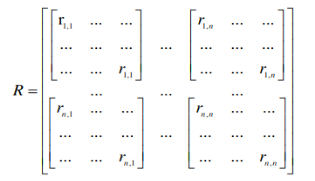
We define below the loss function of the MatMat algorithm, which modifies the classic matrix decomposition The loss function has the following form:

where U and V are all matrices. In this way, we change the vector dot product in the original matrix factorization. Turn vector dot multiplication into matrix multiplication. Let’s take the following example:

Let’s do some performance testing on MovieLens Small Dataset Comparative experiments, the following results are obtained:
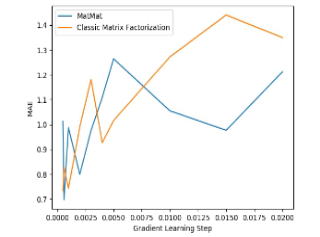
It can be seen that the MatMat algorithm is better than Classic matrix factorization algorithm. Let’s check the fairness of the recommendation system again:
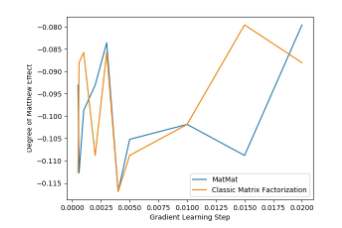
It can be seen that MatMat still performs equally well in terms of fairness indicators. The solution process of MatMat is relatively complicated. Even the author who invented the algorithm did not write the derivation process in the paper. But as the saying goes, if you learn linear algebra well, you will not be afraid of traveling all over the world. I believe that smart readers will be able to derive the relevant formulas and implement this algorithm. MatMat The original address of the algorithm paper can be found at the following link: https://www.php.cn/link/9b8c60725a0193e78368bf8b84c37fb2 . This paper is the Best Paper Report Award of the International Academic Conference IEEE ICISCAE 2021 .
MatMat algorithm is applied in the field of scene-based movie recommendation. The movie instance of this algorithm is named MovieMat. The rating matrix of MovieMat is defined as follows:

The author then conducted a comparative experiment :
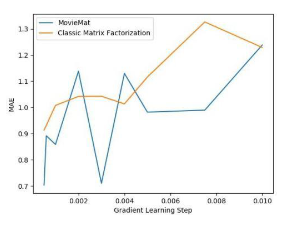
On the LDOS-CoMoDa data collection, MovieMat The performance is much higher than that of classic matrix decomposition. Let’s take a look at the fairness evaluation results:
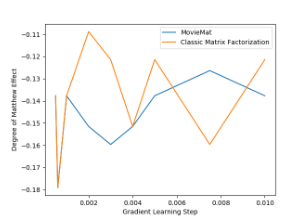
##In terms of fairness, classic matrix decomposition has achieved better results than MovieMat results. The original paper of MovieMat can be found at the following link: https://www.php.cn/link/f4ec6380c50a68a7c35d109bec48aebf .
We sometimes encounter such problems. What should we do when we arrive at a new location and only have scene data but no user rating data? It doesn’t matter, Ratidar Technologies LLC (Beijing Daping Qizhi Network Technology Co., Ltd.) invented ## based on zero-sample learning #CARS Algorithm—— PowerMat. The original paper of PowerMat can be found at the following link: https://www.php.cn/link/1514f187930072575629709336826443 . The inventor of
PowerMatborrowed from MAP and DotMat, the following MAP function is defined:

where U is the user feature vector, V is the item feature Vector, R is the user rating value, and C is the scene variable. Specifically, we get the following formula:

Using stochastic gradient descent to solve this problem, we get the following formula:

Through observation, we found that there are no variables related to input data in this set of formulas, so PowerMat is A zero-shot learning algorithm that is relevant only to scenarios. This algorithm can be applied in the following scenarios: tourists plan to travel to a certain place, but have never been there, so they only have weather and other scene data. We can use PowerMat to recommend check-in attractions to tourists etc.
The following is the comparison data between PowerMat and other algorithms:

Through this picture, we found that PowerMat and MovieMat are evenly matched, is not are comparable, and the results are better than the classic matrix decomposition algorithm. The picture below shows that even in terms of fairness indicator, PowerMat still performs strongly:
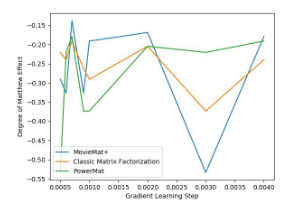
Through comparative experiments, we found that PowerMat is excellent CARS algorithm.
Internet data engineers often say that data is above all else. And around the 2010 era, there was a strong trend on the Internet that was bullish on data and bearish on algorithms. CARS is a good example. Because the vast majority of people do not have access to relevant data, the development of this field has been greatly restricted. Thanks to Slovenian researchers for making the LDOS-CoMoDa data collection public, we have the opportunity to develop this field. We also hope that more and more people will pay attention to CARS, implement CARS, and contribute to CARS Financing……
About the author
Wang Hao, former head of Funplus Artificial Intelligence Laboratory. He has held technology and technology executive positions in ThoughtWorks, Douban, Baidu, Sina and other companies. Working in Internet companies, financial technology, gaming and other companies for #13 years, he has profound insights and rich experience in fields such as artificial intelligence, computer graphics and blockchain. Published 42 papers in international academic conferences and journals, and won IEEE SMI 2008 Best Paper Award, ICBDT 2020 / IEEE ICISCAE 2021 / AIBT 2023 / ICSIM 2024 Best Paper Report Award.
The above is the detailed content of Learn linear algebra well and play with recommendation systems. For more information, please follow other related articles on the PHP Chinese website!

Hot AI Tools

Undresser.AI Undress
AI-powered app for creating realistic nude photos

AI Clothes Remover
Online AI tool for removing clothes from photos.

Undress AI Tool
Undress images for free

Clothoff.io
AI clothes remover

Video Face Swap
Swap faces in any video effortlessly with our completely free AI face swap tool!

Hot Article

Hot Tools

Notepad++7.3.1
Easy-to-use and free code editor

SublimeText3 Chinese version
Chinese version, very easy to use

Zend Studio 13.0.1
Powerful PHP integrated development environment

Dreamweaver CS6
Visual web development tools

SublimeText3 Mac version
God-level code editing software (SublimeText3)

Hot Topics
 1662
1662
 14
14
 1419
1419
 52
52
 1311
1311
 25
25
 1262
1262
 29
29
 1234
1234
 24
24
 Meme Coin Exchange Ranking Meme Coin Main Exchange Top 10 Spots
Apr 22, 2025 am 09:57 AM
Meme Coin Exchange Ranking Meme Coin Main Exchange Top 10 Spots
Apr 22, 2025 am 09:57 AM
The most suitable platforms for trading Meme coins include: 1. Binance, the world's largest, with high liquidity and low handling fees; 2. OkX, an efficient trading engine, supporting a variety of Meme coins; 3. XBIT, decentralized, supporting cross-chain trading; 4. Redim (Solana DEX), low cost, combined with Serum order book; 5. PancakeSwap (BSC DEX), low transaction fees and fast speed; 6. Orca (Solana DEX), user experience optimization; 7. Coinbase, high security, suitable for beginners; 8. Huobi, well-known in Asia, rich trading pairs; 9. DEXRabbit, intelligent
 The top ten free platform recommendations for real-time data on currency circle markets are released
Apr 22, 2025 am 08:12 AM
The top ten free platform recommendations for real-time data on currency circle markets are released
Apr 22, 2025 am 08:12 AM
Cryptocurrency data platforms suitable for beginners include CoinMarketCap and non-small trumpet. 1. CoinMarketCap provides global real-time price, market value, and trading volume rankings for novice and basic analysis needs. 2. The non-small quotation provides a Chinese-friendly interface, suitable for Chinese users to quickly screen low-risk potential projects.
 What are the digital currency trading apps suitable for beginners? Learn about the coin circle in one article
Apr 22, 2025 am 08:45 AM
What are the digital currency trading apps suitable for beginners? Learn about the coin circle in one article
Apr 22, 2025 am 08:45 AM
When choosing a digital currency trading platform suitable for beginners, you need to consider security, ease of use, educational resources and cost transparency: 1. Priority is given to platforms that provide cold storage, two-factor verification and asset insurance; 2. Apps with a simple interface and clear operation are more suitable for beginners; 3. The platform should provide learning tools such as tutorials and market analysis; 4. Pay attention to hidden costs such as transaction fees and cash withdrawal fees.
 Top 10 latest releases of virtual currency trading platforms for bulk transactions
Apr 22, 2025 am 08:18 AM
Top 10 latest releases of virtual currency trading platforms for bulk transactions
Apr 22, 2025 am 08:18 AM
The following factors should be considered when choosing a bulk trading platform: 1. Liquidity: Priority is given to platforms with an average daily trading volume of more than US$5 billion. 2. Compliance: Check whether the platform holds licenses such as FinCEN in the United States, MiCA in the European Union. 3. Security: Cold wallet storage ratio and insurance mechanism are key indicators. 4. Service capability: Whether to provide exclusive account managers and customized transaction tools.
 Summary of the top ten Apple version download portals for digital currency exchange apps
Apr 22, 2025 am 09:27 AM
Summary of the top ten Apple version download portals for digital currency exchange apps
Apr 22, 2025 am 09:27 AM
Provides a variety of complex trading tools and market analysis. It covers more than 100 countries, has an average daily derivative trading volume of over US$30 billion, supports more than 300 trading pairs and 200 times leverage, has strong technical strength, a huge global user base, provides professional trading platforms, secure storage solutions and rich trading pairs.
 Top 10 virtual currency trading platforms with the lowest handling fee
Apr 22, 2025 am 08:30 AM
Top 10 virtual currency trading platforms with the lowest handling fee
Apr 22, 2025 am 08:30 AM
Binance spot trading fee is 0.1%, and holding BNB can be reduced to 0.025%; OKX rate is 0.1%-0.2%, with a minimum of 0.02%; Gate.io rate is 0.2%, with a minimum of 0.10%; FTX rate is 0.02%-0.05%, but has filed for bankruptcy; Coinbase Pro rate is as low as 0.05%, ordinary users; Kraken rate is 0.16%-0.26%, with a minimum of 0.10%; Bitfinex rate is 0.1%-0.2%, with a minimum of 0.02%; Huobi rate is 0.2%, with a minimum of 0.02%; KuCoin rate is 0.1%, with a minimum of 0.02%; Bithumb rate is 0.15%, with a minimum of 0.02%; Huobi rate is 0.2%, with a minimum of 0.02%; KuCoin rate is 0.1%, with a minimum of 0.02%;
 Which of the top ten currency trading platforms in the world are the latest version of the top ten currency trading platforms
Apr 28, 2025 pm 08:09 PM
Which of the top ten currency trading platforms in the world are the latest version of the top ten currency trading platforms
Apr 28, 2025 pm 08:09 PM
The top ten cryptocurrency trading platforms in the world include Binance, OKX, Gate.io, Coinbase, Kraken, Huobi Global, Bitfinex, Bittrex, KuCoin and Poloniex, all of which provide a variety of trading methods and powerful security measures.
 What is on-chain transaction? What are the global transactions?
Apr 22, 2025 am 10:06 AM
What is on-chain transaction? What are the global transactions?
Apr 22, 2025 am 10:06 AM
EU MiCA compliance certification, covering 50 fiat currency channels, cold storage ratio 95%, and zero security incident records. The US SEC licensed platform has convenient direct purchase of fiat currency, a ratio of 98% cold storage, institutional-level liquidity, supports large-scale OTC and custom orders, and multi-level clearing protection.




